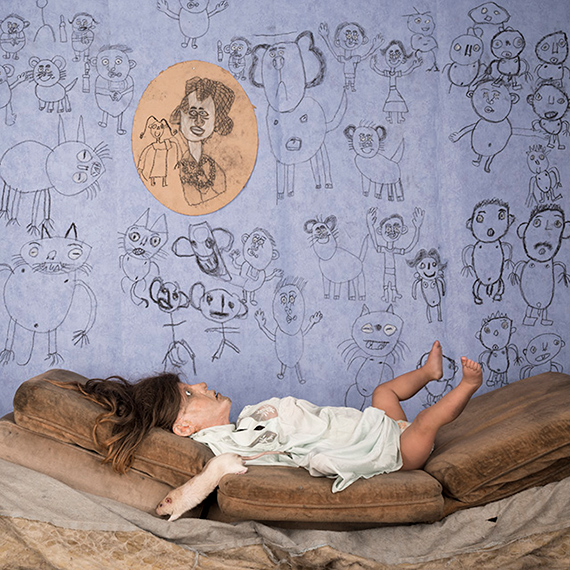
Roger Ballen »
The World according to Roger Ballen
Le monde selon Roger BALLEN
Exhibition: 7 Sep 2019 – 31 Jul 2020

Halle Saint Pierre
2, rue Ronsard
75018 Paris
+33(0)1-42 58 72 89
communication@hallesaintpierre.org
www.hallesaintpierre.org
Mon-Fri 11-18, Sat 11-19, Sun 12-18
Introduction Martine Lusardy
Roger Ballen reigns over the black-and-white world of the human psyche. Disturbing, provocative and enigmatic, the work of this American-born South African photographer, a geologist by training, expresses the sense of confusion of a man confronted by the nonsensical nature both of his life and of the world in general. Ballen’s work has been the subject of exhibitions at prestigious institutions for more than thirty years now. Although each of his shows is an event, his decision to exhibit at the Halle Saint Pierre in Paris, an atypical museum devoted to outsider art and unusual forms of creativity, demonstrates his freedom from artistic genres. For the Halle Saint Pierre, a collaboration with Roger Ballen is an invitation to showcase – or test out – the artistic and cultural otherness of art brut. In his relationship with creativity, Ballen has constantly explored a form of art that is rooted in the deepest layers of human nature; like the French dramatist, actor and writer Antonin Artaud, he is always moving towards more primal means of artistic expression.
It was outside the usual boundaries of culture, in places of confinement and exclusion, that the French artist Jean Dubuffet redefined the territory of art, in the belief that it could be more authentic and personal there. Artists who are resistant or impervious to the norms and values of ‘asphyxiating culture’ are the harbingers of a new relationship with the world, whose unexplored potential they lay bare. To them, creation is life’s act of protest in the fac of the threat of nothingness. The uniqueness of this human experience, as displayed through art objects that are improbable yet capable of reflecting this inner calling, can be grasped only if its strangeness and unsettling nature are grasped too. The zeitgeist recognizes itself in this extreme form of art, and so we must dare to follow the paths it leads us down, reinventing the forms and language that make it perceptible and bearable. Thinking about art brut may offer a direction for our own quest for truth and meaning.
‘From the time I was eighteen in 1968 until September 1973,’ wrote Ballen in Ballenesque (2017), ‘I had a deep existential yearning that neither my Jewish suburban upbringing nor my education could resolve. Like many others from the counterculture, I felt a need to move away from the materialism of Western society […] to follow Conrad’s quest to discover “the heart of darkness”, as well as to seek out the nirvana of the east. In the autumn of 1973, almost without warning, I left the United States on a five-year journey that would take me by land from Cairo to Cape Town, from Istanbul to New Guinea.’ After returning to the US, Ballen completed his first photography book, Boyhood (1979) – a personal view of the timeless theme of childhood – and, in 1981, received his PhD in mineral economics. A year later, he moved to Johannesburg in South Africa; but the financial security that his career as a geologist gave him did nothing to halt his ongoing quest into the meaning of life. And so, equipped with his camera, he began to devote himself to another activity: exploring a South Africa that is poverty-stricken and deeply rural, a suppressed Africa, like a metaphor for an introspective, aesthetic journey in search of identity.
When Ballen photographs South Africans marginalized by fear, poverty and isolation, he transforms the existence of those who live in a world of absurd and repetitive gestures into another existence, in which they are the artists of a sculptural universe that they themselves have created.
In Dorps: Small Towns of South Africa (1986), Ballen shows us places where both the architecture and the inhabitants are in decline. Fascinated by ‘the faded and crumbling glory of the dorps with their decrepit portents of grandeur and remnants of unfulfilled promises’, he enters into a world, both literally and metaphorically, where he records visual and cultural anomalies as the signs of a dying culture. Later, in Platteland (1994), he shows us a realistic and deeply affecting portrait of the rural world during apartheid. He photographs people caught up in political, economic and racial turmoil within the intimacy of their daily lives, with all their physical and psychological flaws. But rather than the events themselves, it is the traces of visual drama they leave behind that interest him most. Many of the walls in his images acquire the quality of works of art and would not look out of place in a museum. For Ballen, this is an awakening not only of consciousness but also of vision. In fact, although they inevitably possess a documentary and social weight, his photographs are not socially determined images. The act of taking photographs entails not an act of witnessing but a need to transfigure. These are the depths of the human soul that Ballen’s photography explores, places where a world that has lost its sense of balance leaves confusing traces as it passes by.
Since 1995, Ballen’s visual experimentation has continually blurred the borders between fiction and reality. Moving from an aestheticization of the real to an aestheticization of the unconscious, his photography mines a psychological landscape that to some degree recalls the mindscapes of Dubuffet – the ‘landscapes of the brain’, as he called them – through which the painter tried to recreate the immaterial world inhabited by the human mind. But it is the theatre of Samuel Beckett that Ballen’s oeuvre seems to echo most closely. Like the playwright before him, he expresses a sense of confusion and alienation in the face of an irrational and incomprehensible world in which man, helpless and dispossessed, carries the weight of the human condition inside himself. Just as Beckett did, Ballen feels the need to depict this reality in all its absurdity.
Outland (2001), Shadow Chamber (2005) and Boarding House (2009) mark the clear development of a unique style and vocabulary. Ballen introduces deliberate mise en scène, which he uses to capture existential vertigo; beneath the theatre lies the truth. The marginal figures he engages with, and with whom he has gradually built up strong and sympathetic relationships, become the comic and tragic actors in his psychodramas, no longer in a social context but within a formal artistic world. Their gestures and preoccupations, now intensified, seem to be stripped of meaning. Their bodies, their ‘vehicles of being-in-the-world’ (to quote Maurice Merleau-Ponty) – shrunken, decrepit and deformed, and sometimes existing only as fragments – bear witness to their turmoil at having lost any obvious connection to the universe.
All of these characters are shown within indeterminate cell-like spaces, squalid, dusty and windowless; only the omnipresent walls remain to delimit a physical and mental state of being. Covered in symbols, sketches and graffiti, the smudged walls become a record of stories, beliefs and impossible flights of fancy. Together with animals, worn-out objects – some trivial, some bizarre – are elevated to the role of surreal protagonists in scenes whose meaning they blur even further. Metal wires and electrical and telephone cables, hanging and tangled, obsessively invade the spaces like symbols of lost connections. Absurdity both dominates and structures space. Little is left to chance, but nothing has any obvious meaning, just as Beckett’s writing overturns standard grammatical rules and constructions.
Asylum of the Birds (2014), the culmination of several years’ work, is a place of both refuge and imprisonment. Dramatic and dreamlike, it speaks of the human condition, even when humans are absent. In a setting filled with detritus, a few lost beings, their bodies fragmented or stripped of their verticality, cohabit with a colony of animals. The masters of this space – the birds – fly free, bearing witness to this erasure of human life. Humanity remains only in its traces: dolls, mannequins and masks, its doubles in various forms; dismantled objects, relics from a previous life that now exist only in memory; images scribbled on walls, testaments to the ancient desire to recreate the world. Recalling Dubuffet’s late series on ‘non-places’, with its deeply nihilistic inspiration, Asylum is an attempt to represent not the world but its incorporality, that nothingness filled with the phantoms and phantasms we project on it.
References to the real world disappear completely in The Theatre of Apparitions (2016). In this book’s images, which occupy a space between painting, drawing and photography, the human figure becomes spectral, reduced to its impulses, its desires and its anguish.
The world according to Roger Ballen has evolved over the years, born from and within his relationship with photography. His encounter with the social and psychological realities of South Africa, most notably in the dorps, was clearly a formative experience: ‘The discovery of such places meant that I would frequently return, drawn for no explicable reason whatsoever.’ If it is unsettling to see these domains chosen for their formal and aesthetic qualities, it is because, situated beyond history, they seem to strip bare the sense of alienation that is still felt in a world in which people have become exiled from themselves. But images must be freed from their indexical nature before the ‘Ballenesque’ world of the imagination can take form as a metaphor of the human condition. The artist explores this imaginary world equally deeply in videos and installations, like theatrical renderings of his dystopian vision. A liminal zone, switching constantly between animate and inanimate, reality and fiction, human and animal, presence and erasure, leads us to an inner realm where all borders are blurred. ‘My images have multiple layers of meaning, and, for me, it’s impossible to say that a photograph is about anything other than myself’, Ballen has said, echoing the words of Dubuffet: ‘The European would do well to occasionally turn aside his gaze that is too fixed on his ideal of the social man, civilized and reasonable, and fix it upon safeguarding something that I believe is extremely precious: the part of his being that remains savage.’